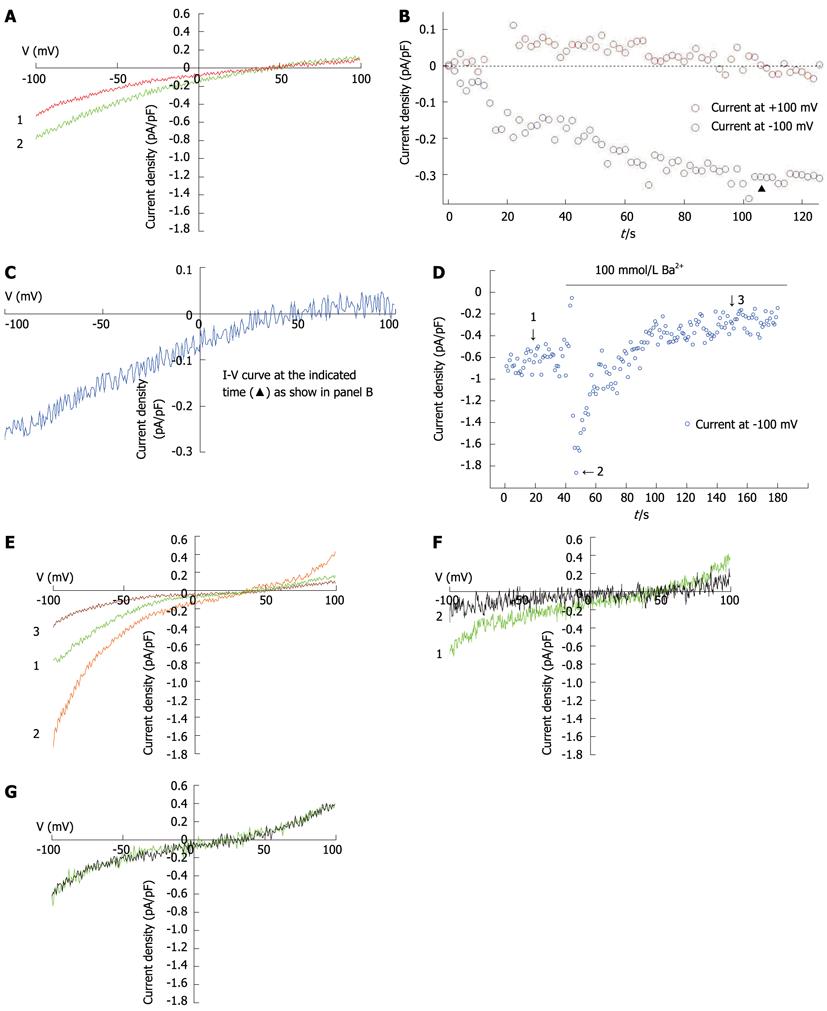Copyright
©2012 Baishideng Publishing Group Co.
World J Gastroenterol. Jan 28, 2012; 18(4): 356-367
Published online Jan 28, 2012. doi: 10.3748/wjg.v18.i4.356
Published online Jan 28, 2012. doi: 10.3748/wjg.v18.i4.356
Figure 4 Store-operated calcium currents in freshly isolated hepatocytes.
A: I-V curves of ISOC induced by 10 μmol/L IP3 and 10 mmol/L ethylene glycol tetraacetic acid (EGTA) in hepatocytes, recorded with the voltage ramps from -100 mV to +100 mV, showing the beginning of whole-cell patch-clamp recording (red) and reaching peak current (green) (n = 14); B: Time course of ISOC development, taken at holding potentials of -100 mV and +100 mV for inward and outward currents, respectively; C: I-V curves of ISOC obtained by subtraction of baseline from peak current (the red and green sections of the trace, respectively, as described in A), at the time marked “▲” in B; D: Currents induced by 10 mmol/L EGTA following replacement of Ca2+ with Ba2+ in the external solution (n = 6); E: I-V curves at the three time points indicated by the arrows in panel D: 1, SOC was fully activated by 10 mmol/L EGTA in the pipette solution, 2, 3, The amplitude of ISOC at -100 mV as a function of time when the external solution was replaced by a solution containing 100 mmol/L Ba2+ and no Ca2+ or Mg2+ for the period indicated in D (n = 6); F: Currents stimulated by 10 mmol/L EGTA. The green trace shows the instantaneous current density-voltage relationship in the range of -100 mV to +100 mV obtained in response to a voltage ramp at the time when inward current was fully developed. The black trace was obtained in response to the presence of 100 μmol/L 2-APB (n = 6); G: Effect of 10 μmol/L A9C on current induced by 10 mmol/L EGTA. The green trace shows the instantaneous current density-voltage relationship in the range of -100 mV to 100 mV obtained in response to a voltage ramp at the time when inward current is fully developed. The black trace was obtained in the presence of 10 μmol/L A9C (n = 5).
- Citation: Pan LJ, Zhang ZC, Zhang ZY, Wang WJ, Xu Y, Zhang ZM. Effects and mechanisms of store-operated calcium channel blockade on hepatic ischemia-reperfusion injury in rats. World J Gastroenterol 2012; 18(4): 356-367
- URL: https://www.wjgnet.com/1007-9327/full/v18/i4/356.htm
- DOI: https://dx.doi.org/10.3748/wjg.v18.i4.356









